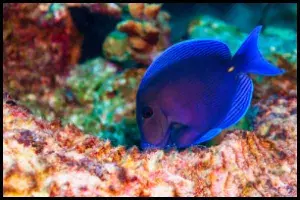
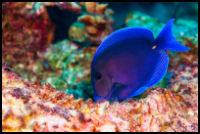
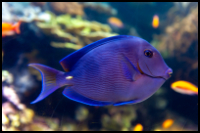
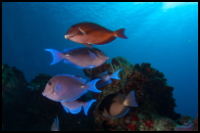

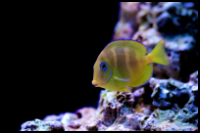
Quick Care Details (Table)
| Livestock Characteristics | Value |
|---|---|
| Care Level | Easy |
| Temperament | Semi-Agressive |
| Diet | Herbivore |
| Maximum Size | 9 Inches |
| Minimum Tank Size | 125 Gallons |
| Reef Safe | Yes |
| Temperature Range | 75-82°F |
| PH Range | 7.8-8.4 pH |
| Alkalinity Range | 8-12 dKH |
| Salinity | 1.022-1.025 |
Species Specific Categories
Helpful Video
Care Details
Aquascape:
- Provide plenty of open space for the Atlantic Tang to swim and explore.
- Incorporate live rock structures and artificial corals to create hiding spots and mimic a natural reef environment.
- Consider adding some rocky formations and caves to offer additional shelter.
Substrate:
- Use a fine sand substrate resembling the natural ocean floor.
- Bare bottom will also work well.
Disease Prevention:
- Quarantine new fish before introducing them to the main tank to avoid potential disease transmission.
- Maintain excellent water quality by performing regular water changes and using a reliable filtration system.
- Observe the fish regularly for any signs of illness or abnormal behavior.
Filtration:
- Use a high-quality protein skimmer to remove organic waste and excess nutrients.
- Consider a canister or sump filter for additional mechanical and biological filtration.
- Ensure the filtration system is appropriately sized for the aquarium and capable of handling the tang's waste production.
Lighting:
- Provide moderate to high-intensity lighting to support the growth of beneficial algae and promote a healthy reef environment.
- Use full-spectrum LED lights to enhance the tang's vibrant coloration.
Water Flow:
- Maintain strong and consistent water flow throughout the aquarium, simulating the natural currents found in the ocean.
- Consider using powerheads or wavemakers to create turbulent water movement, especially in reef environments.
Hardiness:
- The Blue Acanthurus is generally hardy when kept in optimal conditions.
- However, they can be sensitive to sudden changes in water parameters and acclimation stress, so careful monitoring is essential.
Acclimation:
- Slowly acclimate the Atlantic Tang to the new tank environment using the drip acclimation method.
- This gradual process helps the fish adjust to differences in water parameters, temperature, and salinity.
Special Requirements:
- Provide a large aquarium (minimum 100 gallons) to accommodate their active swimming behavior.
- Maintain stable water parameters within the acceptable range: temperature (75-82°F), pH (8.1-8.4), and specific gravity (1.020-1.025).
- Offer a varied diet with high-quality algae-based foods, supplemented with occasional meaty treats.
- Avoid housing the Atlantic Blue Tang with other tang species to minimize aggression and territorial behavior.
Temperament and Behavior
Behavior and Social Interaction:
- Blue Acanthurus are generally peaceful and social fish, often seen swimming in schools in the wild.
- They exhibit curiosity and intelligence, exploring their environment and interacting with other tankmates.
- In captivity, they may display inquisitive behavior, investigating their surroundings and the aquarium inhabitants.
- These fish exhibit inter-species aggression, and should avoid having the same species in the same aquarium.
Aggression:
- While generally peaceful, Blue Tangs can become territorial, especially in smaller aquariums or when kept with other tang species.
- Aggressive behavior is more likely to occur if there is insufficient swimming space or inadequate hiding spots in the tank.
- Providing plenty of open space and creating a well-structured aquascape can help reduce aggression.
Breeding:
- Breeding Atlantic Blue Tangs in captivity is extremely challenging and rare.
- They are pelagic spawners, releasing eggs and sperm into the open water column, where fertilization takes place.
- The larvae require specific conditions and a constant supply of planktonic food, making successful breeding difficult in a home aquarium.
Compatibility:
- Atlantic Blue Tangs are generally compatible with other peaceful community fish that are not aggressive or territorial.
- Avoid housing them with other tang species to minimize aggression and reduce the risk of territorial disputes.
- They can coexist with other species of fish that occupy different niches within the tank.
Activity Level:
- Blue Acanthurus are active swimmers, continuously patrolling their territory and searching for food.
- They require ample swimming space and are not well-suited for small aquariums.
- Providing an environment with strong water flow and open areas for swimming allows them to display their natural activity level.
Clean-up Crew:
- Atlantic Tangs play a vital role in maintaining the health of the aquarium by controlling algae growth.
- Their herbivorous diet helps keep algae in check, contributing to a balanced ecosystem.
- However, they may not consume all types of algae, so it's essential to monitor and manage algae growth in the tank.
Schooling or Shoaling Behavior:
- Atlantic Blue Tangs are schooling fish, often found swimming in groups in the wild.
- Keeping them in a group in the aquarium setting is not a good idea unless you have added all your tangs at the same time.
- adding tangs at the same time gives them a chance to get along before determining territory.
- In captivity, tangs will generally show lots of aggression especially if they look similar.
- consider adding all of them at the same time and adding a lot will help reduce individualized aggressing onto just one tang.
Reef Tank Compatibility:
- These fish are very compatible with a coral reef aquarium.
- They won’t harm invertebrates like shrimp, snails or hermit crabs.
- They will almost never attack any coral of any type, but they might pick at algae growing on a coral.
Diet and Nutrition
Dry Foods:
- Pellet and flake foods are commonly accepted dry foods for the Blue Acanthurus.
- Look for high-quality marine-specific pellets with added vitamins and minerals.
- Choose a size suitable for the fish's mouth to ensure they can eat them comfortably.
Frozen Foods:
- Frozen foods like brine shrimp, mysis shrimp, and plankton are well-received by Blue Tangs.
- These foods retain much of their nutritional value and are easy to store.
Live Foods:
- Blue Tangs may occasionally eat live foods like copepods and amphipods found in live rock.
- Some aquarium hobbyists cultivate live foods for their Blue Tangs to supplement their diet.
Vegetables:
- Tangs are herbivorous and enjoy certain vegetables.
- Seaweed sheets or blanched vegetables like spinach, lettuce, and zucchini can be offered.
Algae:
- Algae are a significant part of the Atlantic Blue Tang's diet in the wild.
- In captivity, they can graze on various forms of algae growing on live rock or substrate.
Feeding Schedule:
- Feed adult Blue Tangs 2-3 times a day.
- Juvenile Blue Tangs might need more frequent feedings, up to 4 times a day.
- Avoid overfeeding to prevent water quality issues in the aquarium.
Supplemental Foods:
- Vitamin-rich supplements can enhance the Blue Tang's health.
- Supplements specifically formulated for herbivorous fish are available.
- Provide supplements occasionally or as recommended by the manufacturer.
Tank Parameters
Tank Size:
- A minimum tank size of 100 gallons is recommended for a single Atlantic Blue Tang.
- Larger tanks (125 gallons or more) are preferable, especially if keeping multiple tangs or other fish.
Tank Length and Measurements:
- A tank with dimensions of at least 6 feet (72 inches) in length is ideal for providing enough swimming space.
Species Maximum Size:
- The Blue Acanthurus can reach a maximum size of around 9 inches (23 centimeters) in length.
Water Temperature:
- Maintain the water temperature in the range of 75°F to 82°F (24°C to 28°C).
- Consistent temperature is vital to avoid stress and health issues.
pH (Acidity/Alkalinity):
- Keep the pH level between 8.1 and 8.4 to maintain a slightly alkaline environment.
- Avoid drastic pH fluctuations, as they can be harmful to the fish.
Nitrate (NO3) Levels:
- Keep nitrate levels as low as possible, ideally below 20 ppm (parts per million).
- Regular water changes and proper filtration can help control nitrate levels.
Salinity:
- Maintain a specific gravity of 1.022 to 1.025 (approximately 30 to 35 ppt salinity).
- Blue Tangs are marine fish and require a stable saltwater environment.
- you might want to use an auto top-off unit when adding freshwater to your tank to maintain salinity levels.
Phosphate (PO4):
- Aim to keep phosphate levels low, ideally below 0.03 ppm (parts per million).
- High phosphate levels can lead to algae growth and other water quality issues.
Alkalinity (dKH):
- Alkalinity should be kept in the range of 8 to 12 dKH.
- Carbonate hardness helps stabilize pH levels.
History, Popularity, History and Species Variety Details
The History, Popularity, and Habitat
History and Taxonomy: The Atlantic Blue Tang, scientifically known as Acanthurus coeruleus, is a species of surgeonfish belonging to the family Acanthuridae. This family includes various species of tangs and surgeonfish found in tropical and subtropical marine waters. The Atlantic Blue Tang is native to the Western Atlantic Ocean, spanning from the coast of Florida in the United States down to Brazil. It's commonly found in the Caribbean Sea, the Gulf of Mexico, and adjacent waters.
Physical Characteristics: The Atlantic Tang is known for its striking blue coloration, which varies from light to vibrant shades of blue. It has a laterally compressed body and a pointed snout with small, sharp teeth. Like other surgeonfish, it possesses a sharp, scalpel-like spine near its tail, which can be extended as a defense mechanism. This spine is used for protection against predators and can cause painful injuries if handled without care.
Habitat and Behavior: This Tang inhabits a variety of Atlantic reef environments, including coral reefs, rocky areas, and seagrass beds. It tends to stay in relatively shallow waters, typically around 2 to 30 meters (6 to 100 feet) deep. It is a diurnal species, meaning it is most active during the daylight hours and rests or shelters in crevices and coral formations during the night.
These tangs are herbivorous and feed primarily on algae, which they graze off rocks and other surfaces. Their grazing behavior can help control algal growth on coral reefs and contribute to the overall health of the ecosystem.
Popularity and Conservation: The Atlantic Blue Tang is popular among aquarists due to its vibrant coloration and unique appearance. It gained additional attention as a result of the animated film "Finding Nemo," in which a character named Dory, voiced by Ellen DeGeneres, is depicted as a blue tang.
However, the popularity of the Atlantic Blue Tang in the aquarium trade has raised concerns about overharvesting from the wild, potential damage to coral reefs during collection, and challenges in successfully maintaining them in captivity. Additionally, the collection of wild Atlantic Blue Tangs can have negative effects on local populations, which are slow to reproduce and may not recover easily from overexploitation.
As a result, efforts have been made to promote responsible and sustainable collection practices and encourage aquaculture to provide captive-bred specimens for the aquarium trade. Additionally, awareness about the potential impact of releasing non-native species into local waters has grown, as these fish can potentially disrupt local ecosystems.
In conclusion, the Atlantic Blue Tang is a charismatic and recognizable species that plays a role in both the marine ecosystem and the aquarium trade. Balancing its popularity with the need for conservation and responsible collection practices is essential for its long-term survival and the health of its native habitats.
Red Sea Purple Tang (Zebrasoma xanthurum var. flavescens): This variation is found specifically in the Red Sea region and is sometimes considered a subspecies or color variant of the Purple Tang. It is similar in appearance to the typical Purple Tang but may exhibit slight differences in color intensity.
Hybrid Variants: In the aquarium trade, hybrid variations of the Blue Acanthurus may occasionally be encountered. These hybrids may result from interbreeding between different Zebrasoma species or color morphs, leading to unique color patterns and combinations.
Yellowtail Sailfin Tang (Zebrasoma xanthurum var. veliferum): This variation is often referred to as the "Yellowtail Sailfin Tang" due to the bright yellow coloration of its tail and fins.
Yellow Tang (Zebrasoma flavescens): The Yellow Tang is a popular and iconic marine fish known for its bright yellow coloration. It is native to the Hawaiian Islands and is commonly kept in aquariums.
Sailfin Tang (Zebrasoma desjardinii): The Sailfin Tang, also known as the Desjardin's Sailfin Tang, has a distinctive appearance with a sail-like dorsal fin and a rich mix of colors, including yellow, blue, and white. Its body coloration and patterns are quite different from the Atlantic Blue Tang.
Gem Tang (Zebrasoma gemmatum): The Gem Tang is one of the rarest and most coveted tang species in the aquarium trade. It features a striking combination of black, white, and yellow patches on its body, resembling gemstones. Due to its scarcity and high demand, it is rarely available in the hobby.
Scopas Tang (Zebrasoma scopas): The Scopas Tang has a unique appearance with a brownish-gray body and pale white vertical stripes. Its coloration helps it blend into its natural habitat, providing camouflage from potential predators.
Back to topCommon Tank mates for the Atlantic Blue Tang
- Clownfish (e.g., Ocellaris Clownfish, Percula Clownfish): These small, colorful fish are popular and known for their symbiotic relationship with anemones.
- Damselfish (e.g., Blue Damselfish, Yellowtail Blue Damselfish): Small and hardy fish that come in various colors.
- Royal Gramma (Gramma loreto): A peaceful and strikingly colored fish with a purple body and a yellow tail.
- Firefish (e.g., Firefish Goby, Purple Firefish): Active and peaceful fish that add movement and color to the tank.
- Cleaner Shrimp (e.g., Scarlet Skunk Cleaner Shrimp): These helpful invertebrates clean and groom other fish, forming fascinating symbiotic relationships.
- Bicolor Blenny (Ecsenius bicolor): A personable and peaceful blenny species known for its algae-eating habits.
- Cardinalfish (e.g., Pajama Cardinalfish): Small and peaceful fish that are generally compatible with the Blue Tang.
- Fairy Wrasse (e.g., McCosker's Flasher Wrasse, Carpenter's Flasher Wrasse): Colorful and active fish that add visual interest to the aquarium.
- Coral Beauty Angelfish (Centropyge bispinosa): A dwarf angelfish species that can coexist peacefully with the Blue Tang in larger tanks.
- Filefish (e.g., Orange Spotted Filefish): These fish have interesting patterns and are generally peaceful.
Fish To Avoid Keeping With Your Atlantic Blue Tang
- Other Tang Species: Avoid keeping other Tang species in the same tank as the Blue Acanthurus. Tangs are known for being territorial, and introducing multiple tangs to a limited space can lead to aggression and stress.
- Aggressive Fish: Avoid aggressive and territorial fish, such as large angelfish, triggers, or pufferfish. These fish may harass or harm the Blue Tang and disrupt the peaceful dynamics of the tank.
- Predatory Fish: Predatory fish like lionfish, groupers, or larger predatory species may view the Blue Tang as potential prey, leading to dangerous interactions. Size of the tang and predator will play a key role in their relationship.
- Large, Fast-moving Fish: Fish that are significantly larger and faster than the Blue Tang can cause stress and intimidate the tang, leading to potential health issues.
- Nippy Fish: Certain species of damselfish and butterflyfish can be nippy and aggressive towards the Blue Tang, causing harm to its fins and overall well-being.
- Territorial Invertebrates: Some territorial invertebrates, such as certain types of crabs and lobsters, might not get along with the Blue Tang and can lead to conflicts.
Atlantic Tang's Life Stage Changes from Juvenile to Adult
Juvenile Stage:
Juvenile Atlantic Blue Tangs exhibit a unique and striking coloration that is distinct from their adult counterparts. Instead of the solid blue color seen in adults, juveniles have a bright yellow body with vibrant blue highlights along the edges of their fins. This yellow and blue coloration serves as a form of camouflage, helping them blend in with the coral reef environment and providing protection from potential predators.
During this stage, juvenile Blue Tangs are relatively small, measuring only a few inches in length. Their size and coloration make them incredibly adorable and sought after in the aquarium trade. However, it's essential to note that juvenile Blue Tangs have different care requirements compared to adults, particularly regarding diet and tank size. They are more delicate and can be more sensitive to changes in water quality, so proper acclimation and care are crucial for their well-being.
Transition to Adult Stage:
As the Atlantic Blue Tang grows, it gradually undergoes a fascinating transformation. Over time, the bright yellow coloration begins to fade, and the blue color becomes more dominant. This process occurs as the fish matures and develops into its adult form.
Adult Stage:
In the adult stage, the Atlantic Blue Tang takes on its iconic and dazzling appearance. The body becomes a beautiful, vibrant blue color, with the characteristic yellow accents along the edges of its dorsal and anal fins. The transition from juvenile to adult coloration is awe-inspiring to witness, as the fish evolves into its full glory.
Adult Atlantic Blue Tangs are known for their active and social behavior, often seen swimming gracefully through the coral reef. They are herbivorous, feeding primarily on algae, which plays a crucial role in maintaining the health of the reef ecosystem.
In adulthood, the Atlantic Blue Tang reaches its maximum size of around 9 inches (23 centimeters) in length. Their active nature and vibrant colors make them captivating additions to marine aquariums. However, given their adult size and care requirements, it's essential to provide them with a spacious and well-maintained aquarium to thrive.
Back to topFrequently Asked Questions
What should I feed my Blue Tang?
Atlantic Blue Tangs are herbivorous and primarily feed on algae. Provide a varied diet of high-quality marine pellets, frozen foods (e.g., brine shrimp, mysis shrimp), and vegetable matter (e.g., seaweed sheets, blanched vegetables).
Can I keep more than one caribbean Blue Tang in the same tank?
It's generally not recommended to keep multiple Atlantic Blue Tangs together, as they can be territorial and aggressive towards each other.
Are Atlantic Blue Tangs prone to any specific diseases or parasites?
Like all fish, Atlantic Blue Tangs can be susceptible to various marine fish diseases and parasites. Stress and poor water quality can increase their vulnerability. These fish are especially susceptible to Marine Ich and Velvet which can be very deadly in an enclosed aquarium. It would be best quarantine new fish before introducing them to the main tank to minimize parasites and disease transmission.
How long do Atlantic Blue Tangs typically live?
With proper care, Atlantic Blue Tangs can live anywhere from 8 to 12 years or more in captivity.
How do I handle aggressive behavior in an Atlantic Blue Tang?
If an Atlantic Blue Tang exhibits aggression towards tank mates, consider rearranging the tank's decor to establish new territories or remove the aggressive fish to a separate tank.
Can Atlantic Blue Tangs change color?
Yes, like many fish, Atlantic Blue Tangs can change their coloration slightly based on their mood, health, or environmental conditions. These fish will also undergo color changes from their juvenile stage(yellow) into adulthood colors (blue).

